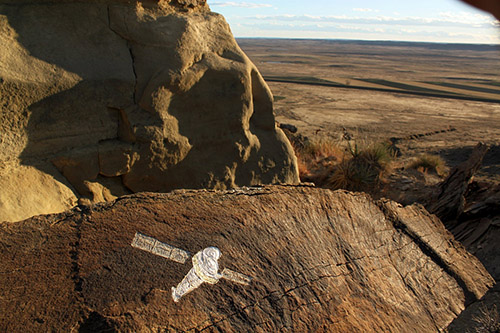Kevin Sudeith, Chandra Observatory over Winter Wheat Fields; November 2010; Rim rock capstone (collapsed),
carving, 21 & 23 carat gold leaf, varnish; 16″x12″; Sumatra Hills, Montana.
Kevin Sudeith practices the oldest extant art form—petroglyph carving—an unusual direction for a contemporary artist whose training includes an MFA from SVA, a BA from San Francisco Art Institute, and summers at Skowhegan and the Yale Norfolk program. Inspired by the human activity surrounding the rock outcroppings that serve as his canvas, Sudeith uses transportation motifs to explore his primary subjects: food, energy, and scientific exploration. He’s also an expert on Afghan war rugs and has introduced them to US audiences through gallery and museum exhibitions and talks. He’s currently at large carving petroglyphs somewhere in the American landscape.
Kris Scheifele: How did your artistic practice become rock carving?
Kevin Sudeith: In 2003, I began making charcoal drawings on rock outcroppings. I quickly realized the work would last longer if it were carved. Experiments in carving ignited my lifelong interest in contemporary imagery and ancient forms. In 2010, I gave up my Long Island City apartment to live on the road making petroglyphs.
Kris: It’s interesting that you feel compelled to make something that’ll last and yet the work is out of the way and anonymous to a degree.
Kevin: Whether people know the name ‘Sudeith’ isn’t as important to me as people seeing the work and responding to it. Afghan war rugs, for example, are great art, but the makers of the rugs are anonymous; this doesn’t temper my love of their work.
And while the stone carvings are remote to most viewers, they serve their local communities where they are reasonably accessible. People near the carvings identify with the carved images. A goal for me is to make large-scale public art in larger communities.
Kris: What are you imagining?
Kevin: There are high rock walls along a section of Interstate 80 heading west as it descends from Wyoming into Utah. The road follows an old wagon trail and I’d like to carve monumental wagon trains next to the freeway. I’d also like to carve and gild life-size satellites. A moose or ocean liner would be challenging.
Kris: How do you decide where you’ll go and what you’ll carve there? Do you embed yourself in the community before you get to work?
Kevin: I work strictly by invitation from friends, their friends, and people I meet on the road. When I arrive somewhere it takes a few weeks of exploring the landscape to find the best carving site. Simultaneously, I explore the local culture, activities, and industry, and I take lots of photographs. For instance, in North Dakota it took a couple of weeks to look for sites while simultaneously photographing farmers, beehives, and oil wells.
Kris: Since you’re invited, have you been accused of trespassing or defacement, things graffiti artists encounter?
Kevin: The vitriol from some people is surprising. In August 2011, a feature ran in the Billings Gazette about my carving in Montana. The website edition featured some angry comments suggesting I was defacing the beautiful wild.
Kris: Scary!
Kevin: Most local people like what I’m doing and are very supportive. After I’ve been working in a community for a while, people are eager to show me their rock outcroppings.
Kris: Have you inspired anyone to make carvings in collaboration with you or on his or her own? It seems like an enticement to add on to your carvings since they are arranged like specimens or catalogs.
Kevin: I would never append a petroglyph made by an ancient, and like contemporary graffiti artists, I’d take it hard if someone messed with my stuff. Territoriality is definitely at play.
Kris: I ask because I read about your watershed trip to Australia where you saw contemporary and ancient Aboriginal images in close proximity. That’s a very different kind of thing serving as an ongoing historical record for a specific society. It seems to me this mixing of time was what inspired you, as opposed to the Native American rock art that surrounded you growing up in Minnesota.
Kevin: There’s a lot more rock art in NW Australia than in Minnesota. The work of the ancients is poignant because it spans thousands of years and is punctuated by the arrival of western figures. The combination of old and new interests me very much and is also at play with the war rugs.
Kris: Tell me about how you’re documenting this work.
Kevin: From the carvings, I make embossed impressions on paper. Time-lapse video documents the time making both the carvings and the impressions. Maps and my database are meant as keys to the whole body of work. Still photos document local life as well as the relationship of the petroglyphs to the landscape. I’m also documenting the stories about the people I meet. For me, this has become one of the most important aspects of the project.
The hundreds of gigabytes of data I’m generating are probably very ephemeral, but the carvings themselves will (most likely) persevere and that’s both satisfying and motivating.
You can see more of Kevin Sudeith’s work at petroglyphist.com
























